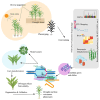Resilience of Maize to Environmental Stress: Insights into Drought and Heat Tolerance
- PMID: 40508082
- PMCID: PMC12155387
- DOI: 10.3390/ijms26115274
Resilience of Maize to Environmental Stress: Insights into Drought and Heat Tolerance
Abstract
Maize (Zea mays L.) is a staple cereal crop worldwide, but its productivity is significantly affected by extreme weather conditions such as drought and heat stress. Plant growth, physiological processes, and yield potential are all affected by these conditions; as such, resilient maize crops are required to tackle these abiotic challenges. With an emphasis on morphological, physiological, and biochemical reactions, this review paper investigates the processes that underlie resistance to certain environmental challenges. Features including deep root systems, osmotic adaptations, and antioxidant enzyme activity help maize withstand drought. Activation of drought- and heat-responsive genes, accumulation of osmoregulatory compounds, and changes in membrane fluidity are all components of abiotic stress tolerance. Likewise, improved transpiration efficiency, modified photosynthetic processes, and improved heat shock proteins are used to produce heat resistance. Enhancing resilience requires progress in breeding methods, genetic engineering, and agronomic techniques, such as the use of stress-tolerant cultivars, biotechnology interventions, and climate-smart agriculture tactics. A special focus was given to cutting edge technologies like CRISPER-Cas9-mediated recent advances in heat and drought resistance. This review sheds light on recent studies and potential avenues for enhancing resilience to harsh climatic conditions, guaranteeing food security in the face of climate change.
Keywords: abiotic stress; climate adaptation; drought resistance; heat stress; physiological responses.
Conflict of interest statement
The authors declare no conflicts of interest.
Figures





Similar articles
-
Genetic, molecular and physiological crosstalk during drought tolerance in maize (Zea mays): pathways to resilient agriculture.Planta. 2024 Aug 28;260(4):81. doi: 10.1007/s00425-024-04517-9. Planta. 2024. PMID: 39196449 Review.
-
Drought stress memory in maize: understanding and harnessing the past for future resilience.Plant Cell Rep. 2025 Apr 25;44(5):101. doi: 10.1007/s00299-025-03494-x. Plant Cell Rep. 2025. PMID: 40278890 Review.
-
Transcription factors as molecular switches to regulate drought adaptation in maize.Theor Appl Genet. 2020 May;133(5):1455-1465. doi: 10.1007/s00122-019-03494-y. Epub 2019 Dec 5. Theor Appl Genet. 2020. PMID: 31807836 Review.
-
Comparative transcriptomic and physiological analyses of contrasting hybrid cultivars ND476 and ZX978 identify important differentially expressed genes and pathways regulating drought stress tolerance in maize.Genes Genomics. 2020 Aug;42(8):937-955. doi: 10.1007/s13258-020-00962-4. Epub 2020 Jul 4. Genes Genomics. 2020. PMID: 32623576
-
Leveraging Multiomics Insights and Exploiting Wild Relatives' Potential for Drought and Heat Tolerance in Maize.J Agric Food Chem. 2024 Jul 24;72(29):16048-16075. doi: 10.1021/acs.jafc.4c01375. Epub 2024 Jul 9. J Agric Food Chem. 2024. PMID: 38980762 Review.
References
-
- Farooq M., Bramley H., Palta J.A., Siddique K.H. Heat Stress in Wheat during Reproductive and Grain-Filling Phases. Crit. Rev. Plant Sci. 2011;30:491–507. doi: 10.1080/07352689.2011.615687. - DOI
-
- Molla M.S.H., Nakasathien S., Ali M.A., Khan A., Alam M.R., Hossain A., Farooq M., El Sabagh A. Influence of nitrogen application on dry biomass allocation and translocation in two maize varieties under short pre-anthesis and prolonged bracketing flowering periods of drought. Arch. Agron. Soil Sci. 2019;65:928–944. doi: 10.1080/03650340.2018.1538557. - DOI
-
- Rojas-Downing M.M., Nejadhashemi A.P., Harrigan T., Woznicki S.A. Climate change and livestock: Impacts, adaptation, and mitigation. Clim. Risk Manag. 2017;16:145–163. doi: 10.1016/j.crm.2017.02.001. - DOI
-
- Vogel E., Donat M.G., Alexander L.V., Meinshausen M., Ray D.K., Karoly D., Meinshausen N., Frieler K. The effects of climate extremes on global agricultural yields. Environ. Res. Lett. 2019;14:54010. doi: 10.1088/1748-9326/ab154b. - DOI
-
- Shiferaw B., Prasanna B.M., Hellin J., Bänziger M. Crops that feed the world 6. Past successes and future challenges to the role played by maize in global food security. Food Secur. 2011;3:307–327. doi: 10.1007/s12571-011-0140-5. - DOI
Publication types
MeSH terms
Grants and funding
- 2023OWSL-04/Open project of Corps Key Laboratory of Efficient Utilization of Water and Fertilizer Resources
- 2022B02015-2/Xinjiang Uygur Autonomous Region Key Research and Development Project
- 2023B02040-1/Xinjiang Uygur Autonomous Region Key Research and Development Project
- XJARS-02/Xinjiang Agriculture Research System
LinkOut - more resources
Full Text Sources

